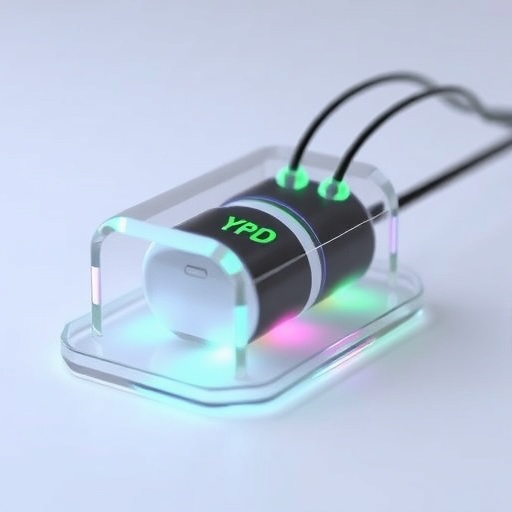In the rapidly advancing field of neuroscience, the need for effective and sophisticated tools to monitor brain activity is more pressing than ever. Traditional methods for probing neural circuits, crucial for understanding cognition and behavior, have relied heavily on two-dimensional interfaces. These limitations stem from planar semiconductor fabrication processes, which have hindered the development of more versatile three-dimensional devices. Neuroscientists are constantly challenging the status quo, seeking innovative solutions that can facilitate deeper understanding of the brain’s complex workings. In a remarkable recent advancement, researchers have unveiled a groundbreaking approach that moves beyond these constraints through the creation of monolithic three-dimensional neural probes.
At the forefront of this innovation is a novel method known as “rolling-of-soft-electronics.” This advanced technique transforms traditional planar devices into three-dimensional neural probes, pushing the boundaries of what is possible in neural recording. By leveraging the inherent softness of flexible electrodes, the researchers can create probes that not only optimize the ability to interface with neural circuits but also enhance the scalability and design flexibility. This breakthrough could represent a paradigm shift in how neuroscientists approach brain-computer interfacing and the recording of complex neural activity.
The rolling-of-soft-electronics method begins with the fabrication of electrode shanks in a single plane. These shanks are subsequently integrated with a flexible spacer, allowing for a seamless transformation into a three-dimensional structure. This process affords researchers the freedom to manipulate various aspects of the design, including shank pitch and the thickness of the spacer layers. The ability to control these design features allows researchers to create a wide variety of device configurations, effectively tailoring the neural probe to suit specific experimental requirements.
What sets this innovation apart from previous stacking or assembly methods is its simplicity and efficiency. Traditional techniques often involve cumbersome processes that can lead to inconsistencies and increased costs. In contrast, the rolling-of-soft-electronics offers a more direct and reliable pathway to achieving high-performance three-dimensional neural probes. With hundreds of electrodes included in these designs, the potential for comprehensive neural activity mapping becomes a reality.
The application of these enhanced neural probes extends beyond theoretical capabilities; practical demonstrations have highlighted their prowess. In groundbreaking studies conducted with rodent and non-human primate models, the probes facilitated single-unit spike recording, showcasing their effectiveness in real-world scenarios. Neuroscience is marked by its requirement for long-duration recordings that capture the nuances of neural activity, and these new probes demonstrate impressive recording stability over extended periods. Researchers observed five-week-long recording stability, a feat that promises to revolutionize longitudinal studies in neuroscience.
Moreover, the versatility of these probes does not stop at simple recordings. The probes enable microscopy-like three-dimensional spatiotemporal mapping of spike activities. This capability is critical for unraveling the intricate dynamics of neural circuits. The ability to visualize and decode spike activities in three dimensions enhances our understanding of how different regions of the brain interact, particularly in complex tasks such as visual processing. In studies focusing on the rodent visual cortex, this technology provided groundbreaking insights into the brain’s processing of visual orientation.
The implications of this research are vast. Neuroscientific inquiries into cognition and behavior often rely on intricate neural interactions, and the success of these three-dimensional probes opens up new avenues for exploration. By utilizing this innovative technology, researchers can delve deeper into the neural mechanisms underlying various cognitive functions, leading to potential breakthroughs in our understanding of disorders such as schizophrenia, autism, and neurodegenerative diseases. This deeper understanding may one day inform the development of targeted therapies and interventions.
As we look to the future, it is clear that the rolling-of-soft-electronics represents a frontier in neural device technology. The design flexibility and high scalability of these three-dimensional probes will likely inspire a wave of new research methodologies and experimental paradigms. As scientists continue to explore the rich tapestry of the brain’s circuitry, the need for advanced tools becomes increasingly crucial. The integration of these innovative devices into standard research practice may soon become commonplace, leading to transformative advancements in neuroscience.
In conclusion, the development of monolithic three-dimensional neural probes through the rolling-of-soft-electronics approach marks a significant milestone in neuroscience. This innovative technology not only overcomes the limitations of traditional probes but also paves the way for enhanced understanding of complex neural dynamics. As researchers harness the capabilities of these advanced probes, the potential for groundbreaking discoveries in cognition and behavior grows exponentially. The future of neuroscience is bright, and this technology has the potential to shine a light on the darkest corners of the brain, illuminating the pathways of thought and behavior in ways previously thought impossible.
In summary, the rolling-of-soft-electronics presents a unique and compelling solution to longstanding challenges in neural recording. Its combination of adaptability, efficiency, and stability positions it as a vital tool in the explorative journeys of neuroscientists worldwide. The advent of these three-dimensional probes offers a glimpse into a future where the intricacies of the human brain can be studied more effectively, driving forward the frontiers of scientific understanding.
Subject of Research: Innovative Monolithic Three-Dimensional Neural Probes
Article Title: Monolithic three-dimensional neural probes from deterministic rolling of soft electronics
Article References:
Qiang, Y., Gu, W., Jang, D. et al. Monolithic three-dimensional neural probes from deterministic rolling of soft electronics.
Nat Electron 8, 721–737 (2025). https://doi.org/10.1038/s41928-025-01431-0
Image Credits: AI Generated
DOI: https://doi.org/10.1038/s41928-025-01431-0
Keywords: neural probes, soft electronics, three-dimensional, neural recording, spatiotemporal mapping, brain activity, cognition, neuroscience.
Tags: advanced neural recording techniquesbrain-computer interfacing technologychallenges in neural interface developmentflexible neural electrodesinnovative neuroscience toolsmonolithic three-dimensional devicesprobing neural circuits effectivelyrollable 3D neural probesscalable neural probe designsoft electronics in neurosciencetransforming planar devices in neuroscienceunderstanding brain activity





